This graph intrigued me when I produced it
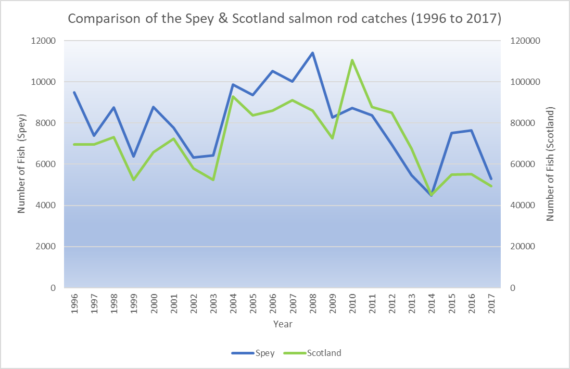
Conveniently the Spey rod catch is approximately 10% of the Scottish catch; as you can see the Spey catch on the left axis extends to 12,000, compared to 120,000 for the Scotland catch. Generally the Spey catches more than 10% of the Scottish catch but during the period five year period from 2010 to 2014 to went negative i.e. dropped below 10%. The Spey seemed to miss out on a good period of catches; this was the era when the Tweed made its famous catch of 23,000+ in 2010, with the bulk of these fish being grilse. That is not to say the Spey missed out completely, the 2009 smolt year class produced a catch of 11,008, but in the Spey the bulk of these returned in 2011 as a strong run of two sea winter fish. By comparison the smolt year classes either side produced meagre returns, 6,314 from the 2008 cohort and 7,243 from the 2010.
I am not sure why the Spey entered that negative phase but the key thing is that it recovered. Proportionally, the Spey catch was higher compared to Scotland in 2015/2016 than in most of the preceding years. The gap narrowed in 2017 and who knows how this season will end although we can be confident that it is not only the Spey that is struggling this year. Reports from across Scotland tell the same story, the run of two sea-winter fish is weak to say the least. Low water is masking the situation, less so on the Spey than on spate rivers where sport has been at a virtual standstill. There are exceptions of course, the Kyle of Sutherland Carron enjoyed a spectacular period in the spring but something in the back of my mind tells me the Carron occasionally performs when others don’t, although the stats may prove otherwise.
The common factor in all of this is the marine phase. Of course there are problems and issues in freshwater, even Spey specific ones such as abstraction, but the poor run this year is too universal to suggest anything other than the marine environment is primarily responsible. I will come onto freshwater issues shortly but there is lots of evidence that the seas, locally and further afield and undergoing a period of change. Hake are now fished for in the North Sea, populations of seabirds in the Shetlands are collapsing, or at least some species are https://www.theguardian.com/environment/2018/jun/03/shetland-seabirds-climate-change-catastrophe-terns-kittiwakes-puffins. There is also a strongly promoted hypothesis that excessive and underestimated stocks of mackerel are not only over grazing the northern seas but could also be predating on salmon post smolts. Around Scotland’s coasts the seal population has burgeoned, this in stark contrast to Scandinavian countries where numbers are strictly controlled. At a nearby river estuary the 700 seals present made the news this week https://www.forres-gazette.co.uk/News/Seals-seen-as-threat-to-salmon-stock-12062018.htm. Nobody really knows how many salmon, or sea trout predators like these take, and there are other, larger, faster moving, predators present in the Moray Firth but we know for sure they take some, perhaps quite a lot – a classic area where more, better, research is needed. One thing is for sure the country is not suddenly going to embrace a Scandinavian approach to wildlife management.
The end result of the collapse in stocks this year and the poor catches is unhappy anglers and much finger pointing at management organisations. There is a palpable sense of doom and gloom, anger even, with some feeling the situation is in terminal decline. A situation such as this always leads to much discussion about the cause with much of this focused on the river; not enough juveniles and too much sawbill predation being the main points of discussion. Predation has always occurred, although the management of this issue on the Spey, appears, to my eyes at least, to be very proactive in comparison to some other areas. Predation is always more of an issue though when returns are poor. Attitudes to bird predation appear to be changing across the rural sector so perhaps our hamstrings will be loosen more in the near future.
Considering the dire catches this year I am not as pessimistic as I should be. That may be due to my usually optimistic disposition but I genuinely don’t share the widespread concern about our juvenile stocks, at present. Right now the river is supporting a healthy crop of parr, and quite possibly fry; it has been a good winter for incubation and a good spring for feeding. Visually there seems to be a lot of parr in the river this year. I hope these anecdotal observations are backed up by our juvenile surveys this summer.
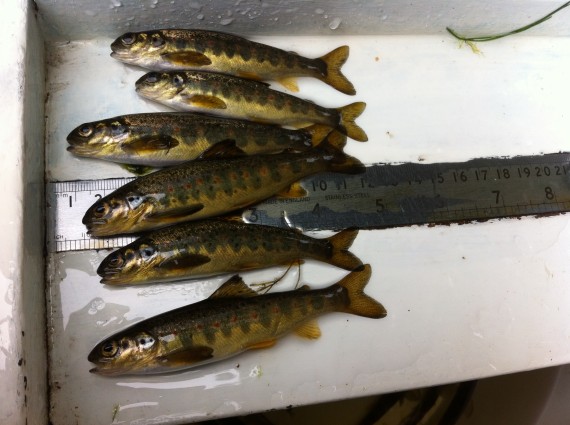
This brings me onto the seemingly contradictory evidence from those who have observed the river, often over many years, and those who collect scientific evidence. “We used to catch a parr very cast, but never, or rarely so now” is something I am told constantly. Indeed I can remember as a boy rummaging about in the nettles and raspberry canes on the banks of the burn at home searching for a parr which unfortunately took on the backcast. I know now they were often salmon parr. I doubt if they are in that burn now; a fish farm, hydro scheme and abstraction have all taken their toll. I have spent much time considering this issue on the Spey, too much as I doubt if it can be resolved, although a recent paper might have shed some light. This article https://www.sciencedirect.com/science/article/pii/S1470160X18303534 shows that capture probability of fish during electrofishing has improved over the years. In 1990 there was a 68% chance that a parr would be caught during electrofishing but by 2010 it was 10% higher, we need to bear this in mind when comparing electrofishing results over time, we are better at catching fish than we used to be.
We don’t have electrofishing data from the Spey mainstem before 2002 but in the tributaries our evidence suggests that, in some sites at least, there has been little change in juvenile densities since the nineties.
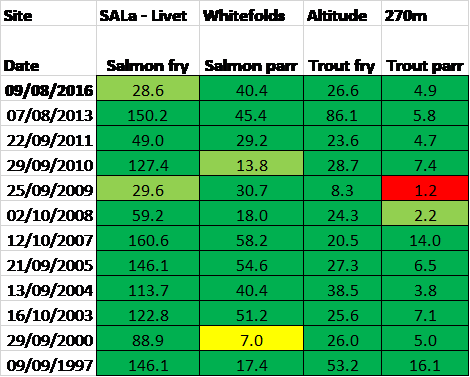
In the absence of objective and comparable information this issue is not going to be resolved but in my view there are still enough fish spawning to produce good fry densities, indeed the Livet data above proves this to be the case (the low counts in 2016 a consequence of the exceptional Storm Frank). If I am correct, and there are enough adults spawning to populate the mainstem then perhaps the carry capacity for parr is not what it was, or there are other factors depressing the population.
The dire catch this year indicates a collapse in the adult run. Dr. James Butler in a presentation years ago talked about a situation whereby if the catch dropped below 3,500, which would indicate a spawning stock of 20,000; then recruitment of juveniles would start of be affected.
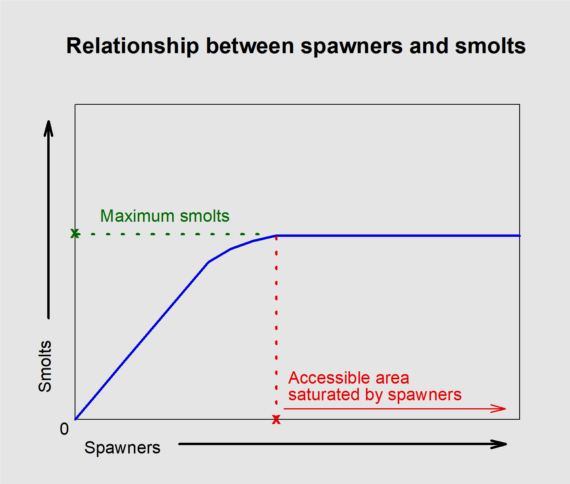
This curve is the basis of salmon management in rivers, and we have probably been on the right of that red cross most of the time in the Spey; this consideration based on catches, juvenile counts, redd counts etc. Density independent factors e.g. Storm Frank can have an overriding impact of course.
I have heard James Butlers words repeated several times over the years, more so this year, by one or two of the ghillies. James said “that if the spawning stock dropped below that point then catches would fall of a cliff”. For sure, a sustained period when the spawning stock drops below the point of maximum smolt production will result in a drop in catches, but a single year will not have a dramatic effect. Salmon have great capacity to expand the population size in freshwater when conditions are favourable, especially where there is vacant habitat.
It is understandable that when catches are poor like they are this year, and they have been dire so far, that there will be even more concern about juvenile stocks. This is the one aspect of the river that we understand best and it is my considered opinion that it is adequate, at present. The Board has already released a statement this year see here when it was stated it was considering range of options local options, as well as a conference later in the year. No-one is complacent about the current situation.

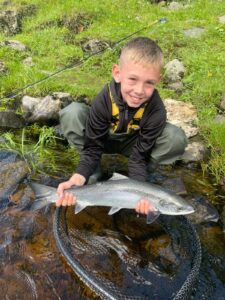

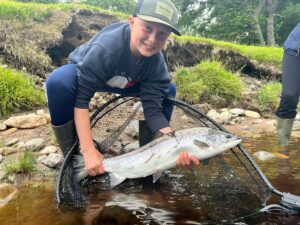


4 thoughts on “Spey juvenile stocks”
Pingback: Spey juvenile stocks – Fisheries Management Scotland
A few questions :-
Why is it always considered that all the problems are at sea?
I have always been convinced that more and more of our juveniles are being consumed by predators before they ever get to the sea? Has the impact of river predation actually been properly considered?
Are these Juvenile electro surveys actually doing anything to preserve or enhance or protect stocks? These after all are the purposes of a district salmon fishery board.
Personally I believe that all these surveys are not doing our young fish any good at all.All that these surveys do is produce wads of statistics in annual reports and simply prove that on a given day there were an estimated number of fish in a stretch of the river. The fact that they might be washed away in a big spate or be eaten by predators subsequently never seems to feature in the equation? They do absolutely nothing for the survival of the species. That has to be the focus of our attention. Stocks are seriously in decline. Action needs to be meaningful.
A few responses to your questions Melville:
– No one, I hope, considers that all the problems are at sea.
– We will be working with the AST on a study on the impact of predation next year.
– Understanding the status of juvenile stocks is a fundamental requirement for their management
– You are of course entitled to your opinion on the value of these surveys. I would like to assure you that all the factors affecting juvenile stocks are taken into consideration.
Regards
Brian
Lets say a sawbill eats 4 parr a day,and lets say there are 500 sawbills in the Spey catchment….do the maths !
365 days of the year for two years.